No. 61 – December 15, 2001 |
Other articles on similar subjects
are published in English
in the monthly Offline column
|
 |
1. Editorial: In memory of Peter Blake |
|
|
Peter Blake was murdered on December 6, 2001 in
Macapà, Amazon. He wasn’t only the famous winner of
the America’s Cup, but also a great sailor in the open seas –
and he had other human qualities, including a keen interest
in the environment. I have a personal reason for admiring him
– my love for the sea and sailing. But there are two lessons
to be learnt that are related to the subject of this newsletter.
- Pirates aren’t just a memory of the past.
They exist today (and not only in remote places). They are
not romantic heroes. They are brutal criminals, ruthless
murderers. To use the definition “pirate” in any
other context isn’t just an abuse of language (and a insult
to victims). It’s a deliberately dirty trick. It makes no
sense to call someone a “pirate” just because he or
she is using a piece of software, or listening to music,
without paying fees to some greedy provider of technology or
entertainment. It can be debatable if doing so is a violation
of a valid contract. But in any case it’s nonsensical that it
be treated legally as a crime (in some countries, including
my own, penalties are almost as severe as those for murder).
- A different lesson comes from the experience of the
America’s Cup. The New Zealand team was unbeatable. Not only
because of the superior performance of their boats, but even
more importantly because of the way their crew worked. There
was total harmony in every detail. Everyone understood
everything. From the beginning of the project, every detail
of the equipment had been designed by people working in close
symbiosis with the people who were going to use it. Even
before Peter Blake was murdered, that very special team was
being disrupted and dismembered by rivals enticing people
away (mostly with money). This sort of thing happens in many
organizations. When “quality circles” are almost
magically generated extraordinary results are achieved. But
they are not always allowed to survive. With so many mergers
and acquisitions, restructuring and reorganizing, human
resources are often sacrificed. The result is deterioration
of quality, loss of motivation, waste of human resources.
This is a serious problem in all human activities – and
especially so in the turbulent evolution of new technologies.
back to top
|
 |
2. Terrorism and internet freedom |
|
|
There is a fair amount of debate in the United States on
how much freedom we should give up for the need to fight
terrorism. Much less in Europe. Governments, authorities,
police and intelligence already have considerable powers of
investigation and interception, and are getting more. Many of
these added powers, and reduced protection of privacy, are of
no use whatsoever in fighting terrorism (or other forms of
crime) while they allow indiscriminate and undisclosed
monitoring and control. Though it’s obviously denied, there
are strong reasons to believe that part of these activities
are used for the benefit of private enterprises – as well as
to collect personal data for commercial use.
What is necessary to fight terrorism and crime needs to
be done. But it should not be used as an excuse for invasive
activities that are unrelated to that objective. This is no
time to relax in the defense of freedom, privacy and civil rights.
back to top
|
 |
3. New worldwide data |
|
|
As said in previous issues – since November 2000
detailed analyses of internet statistics are in the
data section of this site
(now available also in English). This is a summary of the most relevant
information in the most recent worldwide
data, published at the end of November 2001.
The number of internet hosts has increased to 125 million
(it was 109 million at the end of year 2000). Growth is a bit
faster in the rest of the world, but the position of the
United States remains dominant, as is obvious in this chart
(12 countries with over a million internet hosts).
Internet hosts in 12 countries
countries with over a million hosts
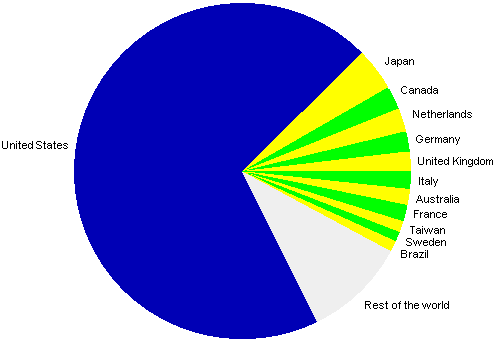
If, for better readability, we exclude the US, this is
the picture for the other 20 countries with over 500,000
hosts.
Internet hosts in 20 countries
countries with over 500,000 hosts (United States excluded)
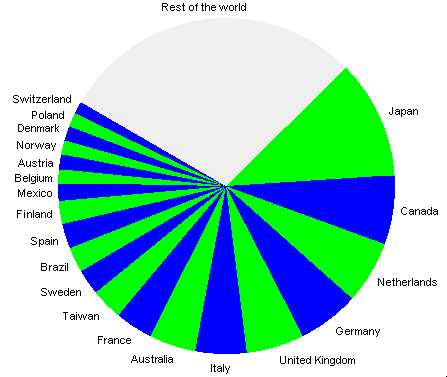
The situation in Italy has changed substantially in thelast two years.
Another major change is the growth of the Netherlands.
According to more recent European data,
Russia would now appear in this chart, with a hostcount over 800,000.
The next chart shows density, in proportion to population,
for the 21 counties with over 500,000 internet hosts.
Internet hosts per 1000 inhabitants in 21 countries
countries with over 500,000 hosts
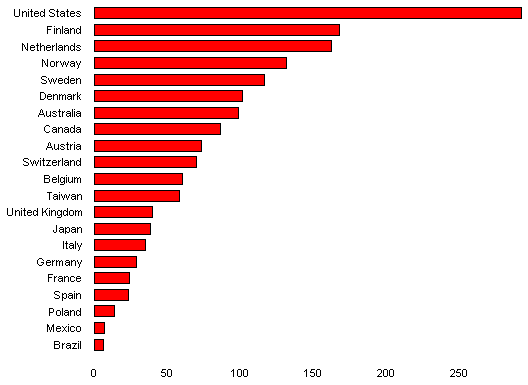
The dominant position of the United States is confirmed
also from this point of view. Density continues to grow in
traditionally strong areas, such as Scandinavia and
Australia, while there are relevant changes in Europe and in
parts of Asia and Latin America.
The next picture is density seen as a world map.
Internet hosts per 1000 inhabitants
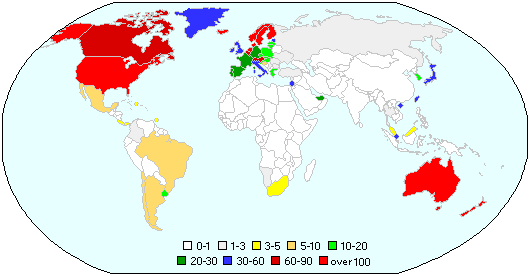
Several countries are growing faster than average, but
the internet is far from being “global”. A large
part of the world is still almost totally excluded.
The next graph shows hostcount in relation to income.
Internet hosts in relation to income (GNP) in 21 countries
countries with over 500,000 hosts
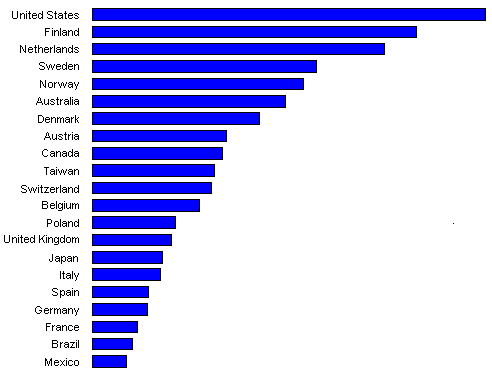
Some large countries (such as Japan, Germany, France and Italy) are
relatively weak in proportion to the size of their economies – as we
had seen also in the analysis of European data.
Some contries in Asia (such as Taiwan) and in Eastern Europe (such as Poland)
appear particularly strong from this point of view.
We can look at the situation from a somewhat different
perspective. There are 12 countries worldwide with over a
million internet hosts. But they are 13 (eight over two
million, that soon will be nine) if we consider cultural
communities – especially the Spanish speaking area.
Internet hosts
numbers in thousands
(United States not included for better readablity of the graph)
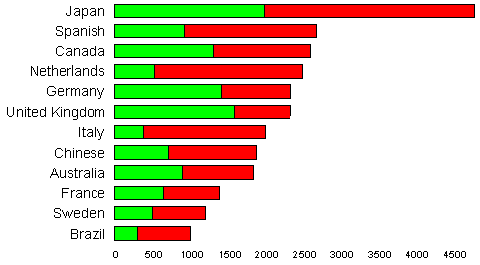
The red part of bars indicates growth in two years (1999-2001)
There is a more detailed document
online about two large language communities – Spanish and
Chinese (so far it’s available only in Italian and Spanish,
but also in this case charts and graphs are clear regardless of language).
The internet is practically unavailable in most of
mainland China, but there is considerable growth in Taiwan,
Hong Kong and other Chinese-speaking areas. The Chinese
online community has probably increased to over two million
internet hosts in the second half of year 2001 (overtaking Italy
– but not yet Germany or Britain).
The Spanish-speaking area has fast growth, with a 75 percent
increase in 12 months (well above the 35 percent worldwide average).
The obvious fact remains that English is dominant, with
70 percent of the total if we consider only countries where
that is the local language – and probably 90 percent if we
include all the people online who can read and write in English.
|
|